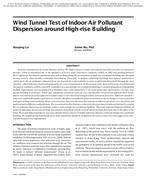-
-
Available Formats
- Options
- Availability
- Priced From ( in USD )
-
Available Formats
-
- Immediate download
- $16.00
- Add to Cart
Customers Who Bought This Also Bought
-

Wind Tunnel Test of Indoor Air Pollutant Dispersion aroun...
Priced From $16.00 -

Removal of Particles by Portable Air Cleaners: Implicatio...
Priced From $16.00 -

Construction of Characterizing System for Saliva Droplets...
Priced From $16.00 -

Self-Reported Common Cold among College Students in China...
Priced From $16.00
About This Item
Full Description
Infectious source strength is a crucial parameter in assessing infection risk and predicting the spread of infection. Descriptive information regarding the outbreak can be revealed from epidemiological investigation, but descriptive epidemiology often cannot provide quantitative information, such as the infectious source strength. Some additional mathematical models are required to estimate this quantitative information from the outcome of the outbreak. In cases of airborne transmissible diseases in indoor environments, spatial patterns of the cases of infection can often be observed as the occupants were likely to have been exposed to different concentrations of the infectious particles. Existing models cannot incorporate the spatial pattern of infection in an outbreak when estimating the infectious source strength, which may cause errors in estimation.
This research aims at performing retrospective estimation of the infectious source strength of an influenza outbreak case during a flight with the aid of Computational Fluid Dynamics (CFD) and likelihood estimation. The approach allows consideration of the spatial distribution of infection in the outbreak in the infectious source strength estimation. In 1999, 20 of 74 passengers were infected with influenza during a 3 hour flight in Australia. The case was reconstructed using CFD. Expiratory aerosols were released from the index case's mouth in the numerical model. Spatial and temporal distribution of the expiratory aerosols in the other passengers' breathing zones and the number of expiratory aerosols deposited on different surfaces were then obtained. Based on the distribution data, the Wells- Riley approach was then used to perform a set of infection risk assessments on the passengers by using a range of quantum generation rate values. Likelihood estimation was then used to correlate the passengers' infection risks to the actual outcome of the outbreak. The quantum generation rate resulting in the maximum likelihood estimation (MLE) was most likely to be the true infectious source strength in the case. Comparison between the infectious source strength estimated by this approach and that ignoring the spatial infection pattern was made. It is found the approach used in the current study gave a more reasonable estimation.
This study shows that CFD and MLE can be used to estimate the infectious source strengths in outbreaks of airborne transmissible diseases. The estimated quantum generation rate can be used as the infectious source strength in other scenarios to perform infection risk assessment of influenza.





